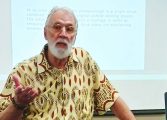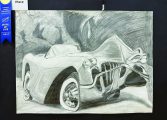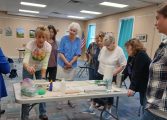By Page H. Gifford
Correspondent
Three local artists and members of the Fluvanna Art Association were among the artists who are exhibiting in the current show at the Purcell Gallery in the Louisa Arts Center. The theme for this show is Artifacts of Louisa County which brought together 25 artists from central Virginia. It was a collaborative effort with the Louisa Historical Society and the Louisa Arts Center.
The artists were tasked with finding inspiration from objects housed at the Louisa County Historical Society. Artists chose artifacts from a diverse group of objects including documents, photos, and three-dimensional objects housed at the Sargent Museum of Louisa County History. Each piece represented one or more objects.
Artist Susan Edginton found inspiration from old photos and a typewriter. The photos (daguerreotypes) were of an unknown Union soldier and Corporal George W. Broaddus of the 30th Virginia Infantry in 1861. The typewriter was a Birkensdorfer No. 7 made from 1897 to 1916. Edginton’s watercolor is a perfect representation of the objects she had chosen. Her muted colors capture the objects’ antiquity.
“As a photographer, I learned in the darkroom to process my black and white images. I was always interested in the history of cameras and film,” said Edginton. “I learned how to type on a manual typewriter and was a typesetter before the first MacIntosh changed everything.”
Tally Ho by Anita Paul is a colored pencil drawing of a sidesaddle owned by the Chisolm Farm dated back to the mid to late 19th century. Side saddles – a chair-like construction, where the woman sat sideways on the horse with her feet on a footrest- are rarely seen at horse shows anymore but are an interesting artifact dating back to the late 14th century. Catherine de Medici developed a more practical design of the side saddle in the 16th century. This enabled women to adhere to cultural norms dictated by fashion. The two-pommel style came out around 1830. With the lower pommel women were able to participate in equestrian sports, foxhunting, galloping, and jumping fences.
“My love of horses and the sheer craftsmanship of any saddle has always intrigued me. My late aunt Blanche Davis was quite an artist when it came to rendering leather. So, the piece spoke to me right away. Therefore, I appreciate deeply the time and work that it took to make this sidesaddle so long ago,” said Paul.
She added that in preparing to do the piece, Pedro Pedrini of Pedrini Saddle Company whose artistry she admires and follows on Facebook, gave her the right insight into portrahing the sidesaddle. Paul’s piece shows the handcrafted details of this well-preserved saddle, a testimony to another age and its cultural norms.
“His insight was valuable in creating this piece,” she said. “I feel honored to have the opportunity to capture this piece. It was a joy to create.”
The third artist participating was Diane Wilkin. Wilkin said she fell in love with the historical development of photography and its impact on social and civic engagement while teaching darkroom skills to high school students. The class also covered the social impacts of photography and included exploring stereoscopes and their double-lensed cameras and the use of stereoscope images for home entertainment – long before television.
“Each card viewed has two images – taken from slightly different angles. When viewed through the stereoscope at about an 8-inch distance, the images blend and appear to have depth.”
Wilkin’s artwork titled The Found View incorporates two images of a forest scene created by a clay printing process with two relief sculptures of tree trunks placed in front.
“If looking through a stereoscope at a photo of the woods of Virginia, the space would appear three dimensional and the trees in the foreground would pop out – as if you were using 3-D glasses.” She made flexible molds from trees behind her house, and blended scrap paper into wet pulp to make the ‘real looking’ texture of the tree forms, adding acrylic and pastel for color once they were dry.
Wilkin’s piece is clever and thought-provoking. She is one of those artists who think far outside and beyond the box when it comes to her work.




